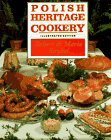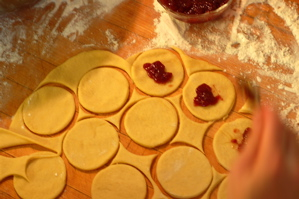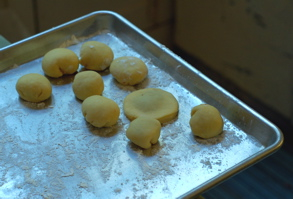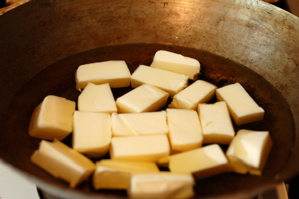 One of the first cookbooks in my collection is also one of my favorites: Polish Heritage Cookery. I came across this heavy tome at a quirky bookstore that once lived on Polk Street, before a fire ravaged the floors above and water rained down upon its randomly, precariously stacked books. The store’s hours were irregular, and those who paid in cash received half off new cover prices. While it was the absolute last place a claustrophobe would want to spend time, Books and Co. was heaven for lovers of books about art, history and food. It epitomized the browsing experience at its most enjoyable.
One of the first cookbooks in my collection is also one of my favorites: Polish Heritage Cookery. I came across this heavy tome at a quirky bookstore that once lived on Polk Street, before a fire ravaged the floors above and water rained down upon its randomly, precariously stacked books. The store’s hours were irregular, and those who paid in cash received half off new cover prices. While it was the absolute last place a claustrophobe would want to spend time, Books and Co. was heaven for lovers of books about art, history and food. It epitomized the browsing experience at its most enjoyable.
Polish Heritage Cookery has the voice I miss in old recipes, where strong opinions and sometimes random advice were sprinkled in among the teaspoons and tablespoons. The authors, Robert and Maria Strybel, gathered an impressive 2,200 recipes covering a wide expanse from vanilla sugar to air-dried Pomeranian pork sausage. While illustrated with helpful drawings for the more complicated recipes, the book is free of photographs. Instead, the recipes unroll in story-like paragraphs and Polish names add poetry to every title. Old World classics and their multiple variations reveal Lithuanian, Italian, French, Jewish, Bohemian and Bavarian influences and trace a fascinating culinary history of Eastern European food.
Whey Soup with Rice (or the sweeter Whey Soup with Raisins), Roast Hare in Sour Cream Polonaise, Carp Baked with Apples, Carpathian Mountain Cake, Cherry Butter, and pages upon pages of pickle recipes include hints that only a grandmother might pass along. Adding skins from black bread helps “hurry-up†the curing of pickles. A glass of cold sour milk is recommended for the morning after “an overabundance of partying.†At the end of a baked potato recipe, the authors note that adding a piece of kielbasa and a tomato would make a balanced meal, while on the next page, hearty Potato and Salt Pork Sausage is not recommended for “those with delicate stomachs.â€
The most stained pages in my own copy of the Strybels’ cookbook span the pastry and preserve chapters. For the last two years, I’ve been hosting Doughnuts of the World brunches. A loose definition of doughnut allows me to experiment with angel wings, churros and beignets. Polish jam-filled paczki, however, would please even the most hard-core of the purists.
Below are excerpts from the Strybels’ detailed description for making small paczki.

Homemade raspberry jam stands in for the rose-hip jelly, cherry preserves or powidla (thick plum butter) suggested in the original recipe.
“Although these luscious doughnuts are available year-round at Polish pastry shops, they reign supreme on Thusty Czwartek (Fat Tuesday), which begins the final fling of the Pre-Lenten karnawal of zapusty. More paczki are sold that day than at any other time of the year. You can try your hand at making your own by proceeding according to this recipe. Dissolve 2 cakes crushed yeast in 1 c. lukewarm milk, sift in 1 c. flour, add 1 T. sugar, mix, cover, and let stand in a warm place to rise. Beat 8 egg yolks with 2/3 c. powdered sugar and 2 T. vanilla sugar until fluffy. Sift 2 1/2 c. flour into bowl, add sponge, egg mixture, and 2 T. grain alcohol or 3 T. rum, and knead well until dough is smooth and glossy. Gradually add 1 stick melted lukewarm butter and continue kneading until dough no longer clings to hands and bowl and air blisters appear. Cover with cloth and let rise in warm place until doubled. Punch down dough and let rise again. Transfer dough to floured board, sprinkle top with flour, and roll out about 1/2 inch thick. With glass or biscuit cutter, cut into rounds. Arrange on floured board.†[NB: I substituted 1 1/2 packets of dry yeast for the yeast cakes.]

The soft dough feels lovely. Still, some of my guests decide flat, American-style jelly doughnuts are easier to form and fry.
“Place a small spoonful of fruit filling (rose-hip preserves, cherry preserves, powidla, or other thick jam) off center on each round. Raise edges of dough and pinch together over filling, then roll between palms snowball fashion to form balls. Let rise in warm place until doubled.â€

The Strybel’s write that Polish pastries like paczki “may be fried in vegetable shortening or oil instead of lard, but they won’t be as tasty. The choice is yours.â€
“Heat 1 1/2-2 lbs. lard in deep pan so paczki can float freely during frying. It is hot enough when a small piece of dough dropped into the hot fat immediately floats up. Fry packzi under cover without crowding several min. until nicely browned on bottom, then turn over and fry uncovered on the other side another 3 min. or so. If fat begins to burn, add several slices of peeled raw potato which will both lower the temp. and absorb any burnt flavor. Transfer fried paczki to absorbent paper and set aside to cool, When cool, dust generously with powdered sugar, glaze or icing.â€
When I think of the amount of times I’ve ‘soothed myself’ or been soothed, with jelly (jello) as a little one. While those times were years ago